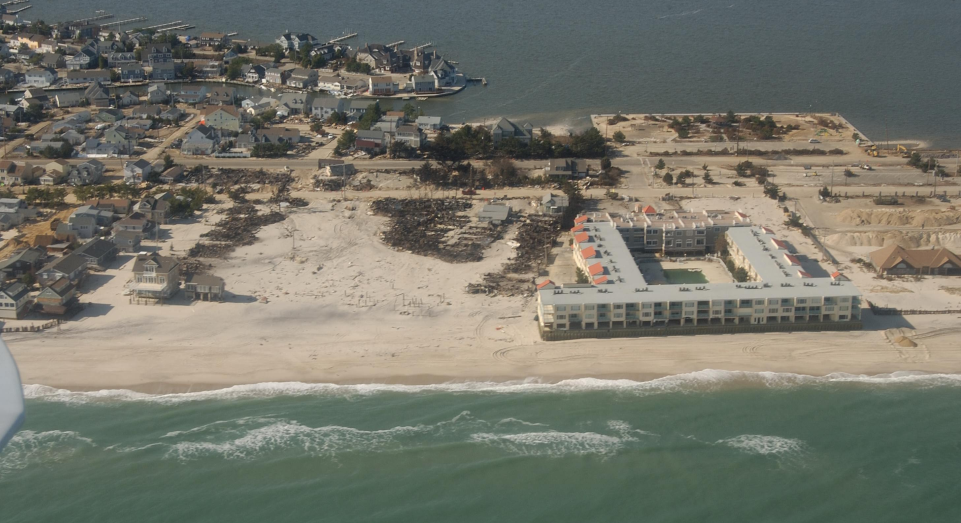Modeling the effect of hard structures on dune erosion and overwash
Worldwide, many of the most densely populated areas are located near the coast. Climate change and population growth put more and more pressure on these coastal areas. This leaves coastal zone managers with a difficult task, as free space is becoming sparse, coastal disaster risk reduction plans need to be spatially efficient. In this thesis we address a sandy coast with hard structures, such as buildings or dune revetments. These structures can either provide additional protection, or enhance local erosion by developing a scour hole in cross-shore direction or result in additional erosion in adjacent locations. Field measurements and experimental data featuring these phenomena are scarce, but the measurements of the devastating impact of hurricane Sandy on the New Jersey shore provide new model validation possibilities by introducing a new field case. Figure below shows the devastating impact of hurricane Sandy (October 2012) around a hard structure at Camp Osborne, Brick, NJ.
The XBeach model (Roelvink et al., 2009) is used in this thesis as tool to describe the morphodynamic behavior and to investigate the importance of each individual processes. XBeach is a nearshore numerical model to assess the natural coastal response dung storm and hurricane conditions including dune erosion, overwash and breaching. XBeach is depth-averaged and solves 2DH equations for long wave propagation, short wave energy, flow, sediment transport and bottom changes. The XBeach version applied in this thesis is 1.21.3657 with the code name 'Groundhog Day'.
The processes related to the response of the sandy coast during storm conditions are relatively well understood. For example in The Netherlands, the DUROS+ model (van Gent et al., 2008) is the prescribed model for the safety assessment of the dunes. In situations where the safety assessment with the DUROS-model are not adequate, administrators can decide to use more generic models. This level of knowledge is not present for the impact of a 'hard' element or the impact of a hard-soft transitions on the amount of erosion during storm surges. The effects which have been described in theory and in experiments are divided in:
- Cross-shore. Experiments (WL | Delft Hydraulics, 1993) have reproduced the development of scour holes during storm surges, both in front and behind hard elements. These effects have been reproduced in the process-based model XBeach (Van Thiel de Vries, 2009)
- Longshore. Flume experiments (Boers et al., 2011) have shown that structures can result in an increased set-back of the dune. These effects have been reproduced in the process-based model XBeach (Van Geer et al., 2012). In order to describe this effect calculation rules are derived to determine the increase in dune retreat (Deltares and Arcadis, 2013).
In order to understand the impact of hard elements and to investigate the influence of individual processes (causes) a validated process-based model can be used. For validation and evaluation of models and relations, measurements are necessary.
 
Pre- and post-storm oblique aerial photographs of the impact of hurricane Sandy (2012). Pictured is a dominant condo placed in the barrier of Camp Osborne, Brick, NJ. The additional erosion in the overwash fan left of the condo is clearly visible. Pictures are taken on 21/05/2009 and 05/11/2012. Taken from the U.S. Geological Survey. Source: http://coastal.er.usgs.gov/hurricanes/sandy.
References
Deltares, & Arcadis. (2013). Calculation rules objects in dunes (Dutch: Handreiking NWO in duinen). Delft: Deltares.
Boers, M., van Geer, P., & van Gent, M. (2011). Dike and dune revetment impact on dune erosion. Proc. Coastal Sediments Miami, FL
Roelvink, J. A., Reniers, A. J. H. M., van Dongeren, A. R., van Thiel de Vries, J. S. M., McCall, R. T., and Lescinski, J. (2009). Modelling storm impacts on beaches, dunes and barrier islands. Coastal Engineering, 56(11--12):1133 – 1152.
Van Geer, P., de Vries, B., van Dongeren, A., & van Thiel de Vries, J. S. M. (2012). Dune erosion near sea walls: model-data comparison. Coastal Engineering, 1--9.
Van Gent, M., van Thiel de Vries, J. S. M., Coeveld, E. M., de Vroeg, J. H., & van de Graaff, J. (2008). Large-scale dune erosion tests to study the influence of wave periods. Coastal Engineering, 55(12), 1041--1051.
Van Thiel de Vries, J. S. M. (2009). Dune erosion during storm surges. PhD. Delft University of Technology, Delft.
|


